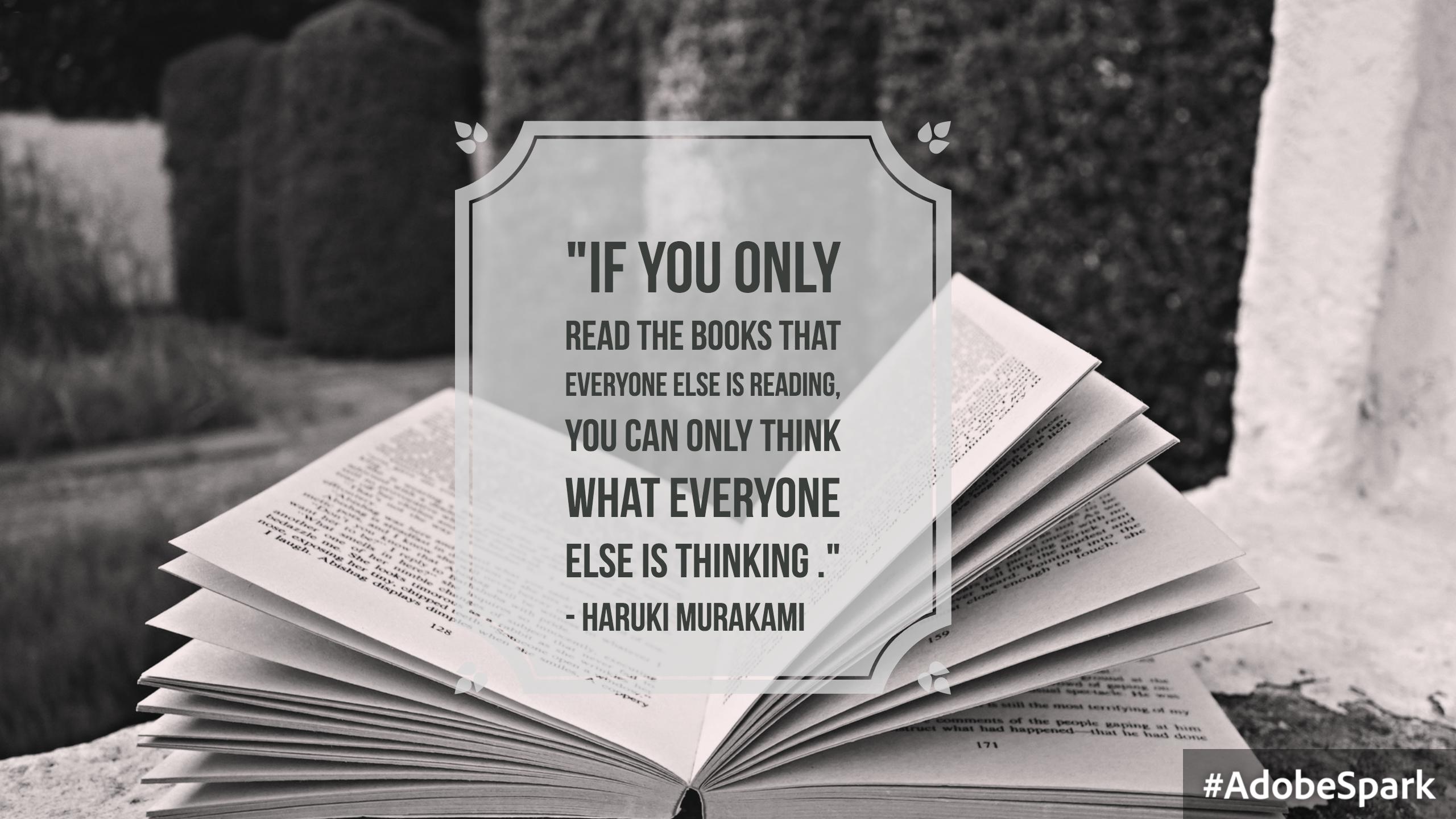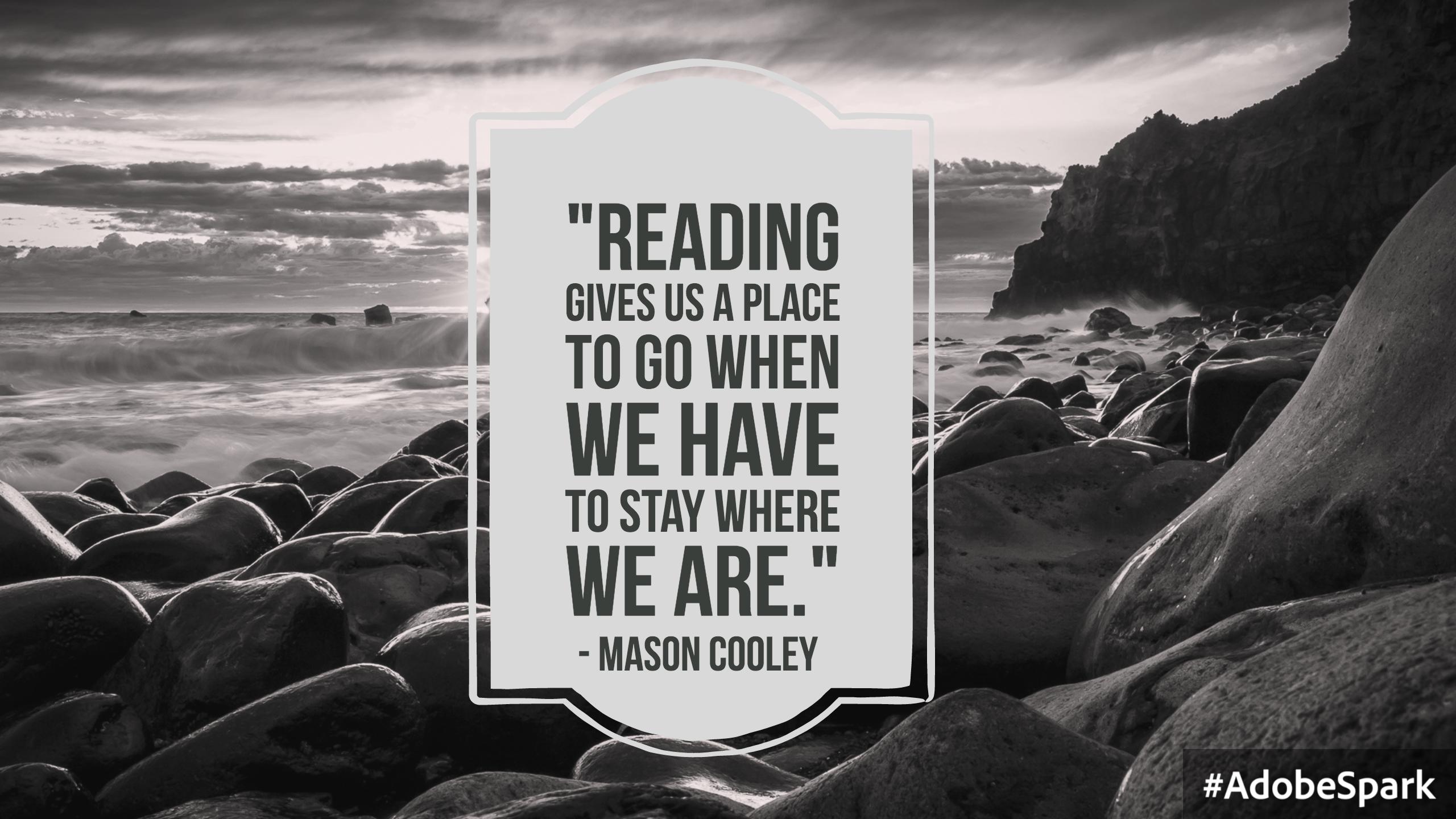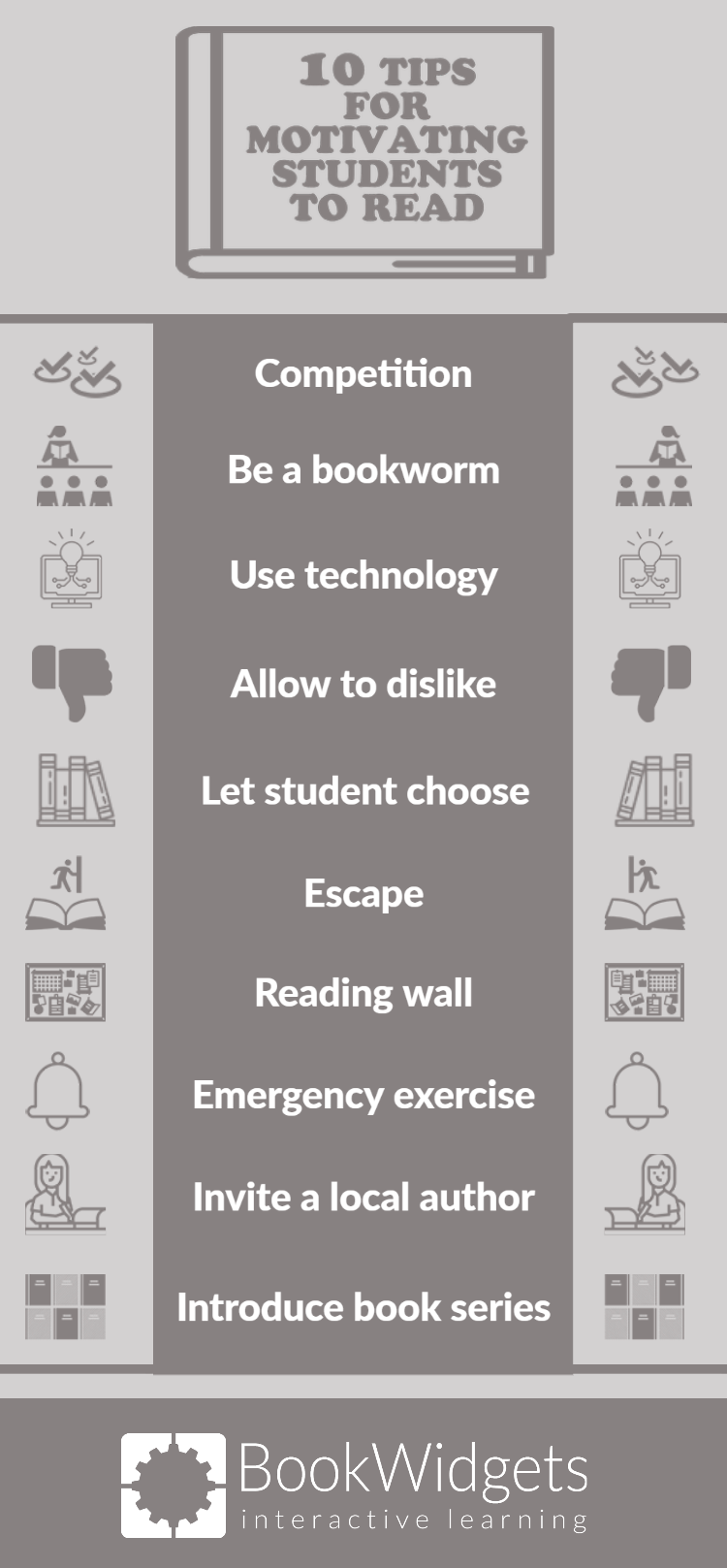Top-10 tips for motivating students to read
 Lucie Renard —
Lucie Renard —
In this blog post I will give you some tips on how to get your students motivated to read a book. It must be so frustrating to see your students hating books, while you love reading. Trying to convince them to read, but really knowing it is just not going to work.
“Reading is stupid!” At least, that is what the students think. And to be honest, I thought so too, until I learned that reading could also be relaxing, engaging and fun. I remember I first started to like reading because it was my own choice. Not my teachers’. But I have to say, it took a while…
I underwent the whole ‘pick-from-the-list-method’, year after year. In primary school, I pretended to read, but I actually didn’t. When the teacher said: “that, you have to read”, I just put a zero on the top of the page. Just like everyone else, nobody actually read it.
If it wasn’t for a fantastic teacher in my third year of high school, I would never have discovered the true value of reading. For the first time, we got to choose a book. By ourselves. Alone. And look at me now: writing blog posts people are actually reading! Playing with words to capture your attention.
It’s time to discover how to encourage reading. 📖

10 Tips and tricks
1. Competition
 What better way to spice up literature than a good competition? This one won’t be about grades, it’s about giving children an incentive to open a book.
What better way to spice up literature than a good competition? This one won’t be about grades, it’s about giving children an incentive to open a book.
For example: You can make a grid with all kinds of book genres. The students can choose which book they read, as long as it belongs to one of the indicated genres. They have to tick off each genre when finishing that book.
Another fun idea is the “16 before you’re 16 challenge”. Here, the students have to try to read 16 books before they reach their 16th birthday. Of course, it’s a project that is spread over the years and must be encouraged by every teacher.
2. Be a bookworm
 If you’re going to encourage students to read, you must read too. Read for pleasure, for information, read blogs, instructions, read to connect with others. Make your students notice you reading. Advertise and tell stories you find in books. Give subtle or not-so-subtle hints. Let the book be the smartphone: everywhere, all the time.
If you’re going to encourage students to read, you must read too. Read for pleasure, for information, read blogs, instructions, read to connect with others. Make your students notice you reading. Advertise and tell stories you find in books. Give subtle or not-so-subtle hints. Let the book be the smartphone: everywhere, all the time.

3. Use technology
 Engaging students to read is easier with technology. Using technology makes reading fun. Technology and apps are already a part of a student’s world. It’s in their comfort zone. Here is a list of 7 platforms and apps that are really useful for making students love reading.
Engaging students to read is easier with technology. Using technology makes reading fun. Technology and apps are already a part of a student’s world. It’s in their comfort zone. Here is a list of 7 platforms and apps that are really useful for making students love reading.
- Epic! - books for kids. Epic! is an e-reader app designed for students aged 12 and under. It gives users access to thousands of books and the ability to set up user profiles for brothers and sisters, and even parents. It has a reward system where kids can earn badges for reading accomplishments and it keeps track of how many books they’ve already finished. The app is designed for smartphones, tablets and computers.
- BookWidgets is a platform with a huge range of different educational features for the tablet and computer. In the Split Worksheet the teacher can add a reading comprehension. While reading, the students have to try and fill in the questions alongside of the text. It makes reading more engaging and fun at the same time. The WebQuest is a widget where you, for example, can learn students how to read efficiently. Let them go on a quest where texts provide the right information about reading strategies.
- OverDrive is a free app that connects to the students’ library card. Many libraries will let them access e-books through this app. If students are not sure which library supports the card, they can take a look at OverDrive’s website to see which libraries participate.
- iBooks Author let teachers create their own interactive books for iPads and computers. By adding galleries, video, interactive diagrams, 3D objects, mathematical expressions, and many more, these books bring content to life and engage students to love reading.
- Whooo’s Reading can be used to motivate students to read in order to earn Wisdom Coins for reading, answering open-ended comprehension questions, and interacting with their peers in a private Facebook-like Newsfeed. These coins can be spent in the Owl Shop, where students “buy” virtual accessories for their Owlvatar.
- Useful science is a website full of fun facts in categories such as education, happiness, sleep and creativity, fitness, health, nutrition, parenting, persuasion and productivity. Students can choose a category and scroll for hours reading fun facts.
- Newsela builds reading comprehension through leveled articles, real-time assessments and actionable insights. Students can read articles on their own tempo. Newsela offers articles from world class news publications in 5 adaptive reading levels. You can also unlock progress with embedded assessments like quizzes.

These 7 platforms or apps that engage reading are just a few out of the many other existing ones. Take a look at this blog post about reading apps for more inspiration.
One more thing: encourage students to listen to audio books. While they are not developing decoding or fluency skills, they are acquiring vocabulary, applying comprehension strategies, enjoying stories and gaining information.
4. Allow students to dislike a book
 There’s nothing wrong with disliking a book. But even if that’s the case, some students will write a glowing book review, thinking that will get score them better grades. That’s a silly misconception, of course. Everyone has its own opinion about stories. Some students like reading drama, others are more into science-fiction or detectives.
There’s nothing wrong with disliking a book. But even if that’s the case, some students will write a glowing book review, thinking that will get score them better grades. That’s a silly misconception, of course. Everyone has its own opinion about stories. Some students like reading drama, others are more into science-fiction or detectives.
If the student can give a well-founded opinion about why it dislikes a book, you can use it to adjust your booklist or to let students choose a book genre they really like. Appointing books inline with their preferences takes you one step closer to persuading students to read.
5. Let students choose
 A list of books to choose from turns off students immediately. Students have to choose a book, based on its title. Why not let students choose for themselves? Not only does it give them a trustworthy feeling, but it also gives them freedom to read what they like. If they like a book, they’ll be more willing to read again, and again and again. Of course, as a teacher, you can still approve or reject their choises and have a back-up list for students who don’t know what to choose.
A list of books to choose from turns off students immediately. Students have to choose a book, based on its title. Why not let students choose for themselves? Not only does it give them a trustworthy feeling, but it also gives them freedom to read what they like. If they like a book, they’ll be more willing to read again, and again and again. Of course, as a teacher, you can still approve or reject their choises and have a back-up list for students who don’t know what to choose.

I know that handing “the choosing” over to students comes with a few difficulties. You will need a creative solution for students who actually already have read the book some time ago, or for students who copy the summary from the internet. You can, for example, let them do a roleplay from a specific scene in the book. Plan an exercise that requires the student’s creativity, something that can’t be found on the internet. Creative and active book assignments are much more fun than just writing down the summary or describing the characters.
6. Escape
 Kids often need a break from reality. Not thinking about homework or exams. Not thinking of their parents, hobbies or friends. Now the escape is often the television or smartphone, but it could easily become a book. Start by escaping in school. Read with your students half an hour a week. Everyone can escape in its own book. Go sit outside if the sun is shining or create an “escape paradise”, which is a transformed reading classroom.
Kids often need a break from reality. Not thinking about homework or exams. Not thinking of their parents, hobbies or friends. Now the escape is often the television or smartphone, but it could easily become a book. Start by escaping in school. Read with your students half an hour a week. Everyone can escape in its own book. Go sit outside if the sun is shining or create an “escape paradise”, which is a transformed reading classroom.

7. Reading wall
 Your school probably has a few blank walls in a hallway. Why not make a reading wall out of it? Maybe there is some place in the student’s library? With a reading wall you can creatively advertise teachers favorite books, books recommended by students, award-winning youth books and many more. Paint a nice theme background and add some shelves against the wall with all the recommended books.
Your school probably has a few blank walls in a hallway. Why not make a reading wall out of it? Maybe there is some place in the student’s library? With a reading wall you can creatively advertise teachers favorite books, books recommended by students, award-winning youth books and many more. Paint a nice theme background and add some shelves against the wall with all the recommended books.
8. Emergency exercise
 Everyone knows the emergency drills in school, right? Yes, the moment where you get to skip 15 minutes or more from class because of the fire alarm that goes off. Well, I think we could do the same with reading books. Every week or month the school sounds an alarm. Students have to drop everything and take a book and start reading. You can gather all the students in one place, or you can keep them in your classroom. If your school doesn’t agree, you can just do it on a smaller scale with a few teachers, or on your own. It would be more fun though, if everyone joins in.
Everyone knows the emergency drills in school, right? Yes, the moment where you get to skip 15 minutes or more from class because of the fire alarm that goes off. Well, I think we could do the same with reading books. Every week or month the school sounds an alarm. Students have to drop everything and take a book and start reading. You can gather all the students in one place, or you can keep them in your classroom. If your school doesn’t agree, you can just do it on a smaller scale with a few teachers, or on your own. It would be more fun though, if everyone joins in.
9. Invite a local author
 Inviting an author to class is a great way to promote the love for reading and encourage students to read. Students can read the author’s book, and then discuss it with him. This may be just the thing to inspire your students to read or even be an author themselves someday. Let the author explain where he gets the ideas, and let him give tips and tricks.
Inviting an author to class is a great way to promote the love for reading and encourage students to read. Students can read the author’s book, and then discuss it with him. This may be just the thing to inspire your students to read or even be an author themselves someday. Let the author explain where he gets the ideas, and let him give tips and tricks.
Afterwards, you let your students write a story. You gather all the stories in one book. Students have to read all the stories and then pick their favorites. The author will also choose a story. The winning student gets their story published in the school paper or even better, in the regional newspaper.

10. Introduce students to a book series
 Nothing is more addictive than a good book series! Whether students are into adventures or fantasy novels, detectives or love stories, there is a book series for everyone. Find out what your students love and get them to read the first book. Once they get a taste of it, they will definitely want to keep reading to find out what happens next.
Nothing is more addictive than a good book series! Whether students are into adventures or fantasy novels, detectives or love stories, there is a book series for everyone. Find out what your students love and get them to read the first book. Once they get a taste of it, they will definitely want to keep reading to find out what happens next.
Wrap up
Now it’s up to you to motivate your students! Let us know on Twitter which tip you use/will use in the classroom. If you have any additional ideas, share them in our Facebook Group. That way, you can inspire other teachers. Together we can change the sentence “Reading is stupid!” to “Reading is great!”.
Would you like to go a step further than just reading? Check out our creative and digital book report ideas.
And don’t forget to say hi 👋 and connect with me on LinkedIn.



